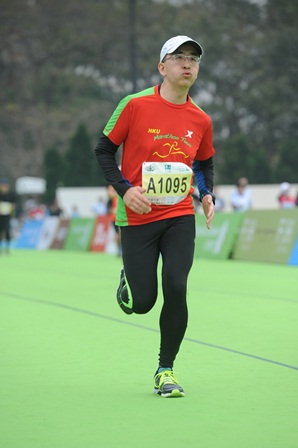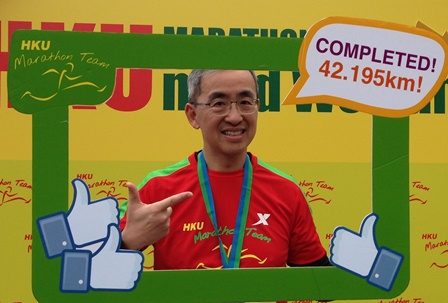SICOT e-Newsletter
Issue No. 67 - April 2014
 Editorial by Kenneth Cheung - SICOT Active Member
Editorial by Kenneth Cheung - SICOT Active Member
Should Orthopaedic Surgeons be running marathons?This is often the first question I am asked when I tell my friends that I have, for the first time in my life, entered for the marathon in Hong Kong.
What my friends mean is that, as an orthopaedic surgeon, surely I should know better than to subject my knees and body to the constant pounding of a 42km race. Would that not just wear out my joints more quickly?
Indeed, this is a question that I have asked myself too. It would seem logical to a non-runner and therefore also to an orthopaedic surgeon. On the other hand, as an academic orthopaedic surgeon, I resorted to an evidence based medicine approach. From my review of the literature, there is no evidence of an increase in risk of joint replacement in long distance runners. Indeed, there is some suggestion that long distance running is associated with better weight control, a lower body mass index (BMI), and therefore mitigates other risks associated with the development of arthritis.
So armed with this knowledge, I began my running career five years ago. This was not an easy decision, since I hated running as a child and I hated the cross-country runs that I was forced to do at school. So for many years I settled for a more sedentary life style and exercising on golf courses.
What triggered my first serious run were my friends. They entered for a 10km marathon in 2009 and invited me to join... it was pure peer pressure. What kept me going, however, were its positive benefits and the changes that I saw in myself.
Running is the most efficient form of exercise that I am aware of, meaning that you can burn the largest amount of calories in the shortest possible time. Coupled with a proper diet, you are guaranteed to lose weight and I lost 10 pounds. Although I wasnât really obese to start with, I do enjoy eating! Doing regular runs means that I can continue to enjoy eating without the fear of gaining weight.
Running is also a means of relieving stress. I used to have bad allergic rhinitis and eczema requiring the regular use of medications. I am convinced that both were aggravated by my long work hours and late nights. Since starting running, both conditions have disappeared.
Running improves stamina, particularly long distance running improves core muscle strength and endurance. As a spine surgeon, I am used to surgeries that take hours. In the past, after long surgeries, my muscles would complain the next day. This is no longer the case. Indeed my family also feels this too, as I am more alert, have more energy, and am more participatory in family events.
Seeing all these benefits and after graduating from my first 10km race, I decided to enter for a race each year, giving myself a target and forcing myself to practice. I became more ambitious in the subsequent few years, entering for the half-marathon (21km). With this increase in distance, I also began to start feeling the strains of running. I suffered from Iliotibial Band Syndrome, learnt the importance of stretching and the use of a foam roller; I also suffered from anterior knee pain, and learnt the importance of running form and shoe-wear.

Long distance running is more than just putting one foot in front of the other. There is a great deal of science and mechanics involved, how the foot should strike the ground to avoid excessive extension moments on the knee, how to train and use your gastroc-soleus to âkickâ, how much knee bend should there be during the swing phase and how far forward should you plant your foot during stance, are all important elements of form that need to be considered to avoid injury. Then there is also the science of training, the interval runs used for increasing cardiovascular endurance, the weekend long runs to build tolerance, and the rest intervals and short runs to allow recovery. During the pre-race days and the race, one needs to remember the importance of carbohydrate loading, proper hydration and pacing.
All of the above became really important when I ran my first full (42km) marathon in February 2014. My pace was good and I was running as planned. I felt great at the half way mark and was still in good form by 30km. But despite my careful preparation, they were still insufficient to prevent me from âhitting the wallâ by 34km. This is the phenomenon in long distance running when endogenous glycogen stores (liver and muscles) are depleted and there is a sudden feeling of fatigue. This hit me at the 34km mark, and for the next 6km it was a real mental challenge to put one leg in front of the other. The tenacity required to continue was huge, but I hung on summoning up every ounce of will-power that I could muster. It got a little easier as I reached the last 2km with by-standers cheering me on, and the adrenaline once again kicking in. I finished the marathon in 5 hours and 30 minutes, not fast, but just happy that I finished... intact and without injuries.

Reflecting back, it was an enormous sense of achievement, enduring the many hours of training, overcoming the mental and physical challenges involved made me a stronger and better person both physically and mentally. I am glad I took the challenge and I shall do so again next year.
If all this did not scare you and you are interested in running a marathon, donât worry, there are many resources on the web that will help you with your running form, training schedules, how to choose proper running gear, plan running routes and logging your runs (e.g. www.runnersworld.com). If you have a smartphone, there are downloadable free apps that will help you plan your training and log your runs. I used a free app called âRunKeeperâ, but this is just one of many.
So âshould orthopaedic surgeons be running marathonsâ? My answer... absolutely!
Â